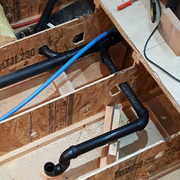|
bEatmstrJ posted:This is what I'm building. Is this thing going to be permanently mounted or not? You can't bury boxes in walls or behind any panel that isn't accessible, so that existing outlet might cause problems, then you probably can't remove that outlet due to the 12 foot spacing rule, which by the way specifically excludes appliance mounted outlets. Oh, and you'd have to check your local code authority on if you're allowed to share the smoke alarm circuit. That one can be weird.
|
|
|
|

|
| # ? May 10, 2024 12:01 |
|
kid sinister posted:Is this thing going to be permanently mounted or not? You can't bury boxes in walls or behind any panel that isn't accessible, so that existing outlet might cause problems, then you probably can't remove that outlet due to the 12 foot spacing rule, which by the way specifically excludes appliance mounted outlets. All those panels will be french cleated to the wall, so everything will be easy to remove and I can undo all of my wiring by taking off two sets of wire nuts. The idea is that I can (optionally) take it with me if I move. I don't know what the code regulations state for mounting outlets inside of removable plywood boxes, but it will all be romexed in using standard wall boxes, just as if it were running through the wall. I'm not sure why that would be an issue since I'm not an electrician, but I'm sure it is.
|
|
|
|
bEatmstrJ posted:This is what I'm building. You have already decided to use zWave remotes, so why not do the next sane thing as well and wire the rest of it safely? Redesign the 2, 3, and 4 parts in such a manner that you can run a cable behind it, with a plug to put in an outlet. Or without the zWave remotes, design that riser part in such a way that a 5/8 conduit fits behind it and run cables for the lamps through those. From the code that applies here, it is illegal to share the neutral between switched circuits the way you drew in your schematic. Because it can lead to situations where the neutral becomes hot.
|
|
|
|
bEatmstrJ posted:All those panels will be french cleated to the wall, so everything will be easy to remove and I can undo all of my wiring by taking off two sets of wire nuts. The idea is that I can (optionally) take it with me if I move. I don't know what the code regulations state for mounting outlets inside of removable plywood boxes, but it will all be romexed in using standard wall boxes, just as if it were running through the wall. I'm not sure why that would be an issue since I'm not an electrician, but I'm sure it is. Honestly, I would wire this whole thing up like it was one big appliance that plugs into a regular outlet via one cord. That way, you could get around a lot of electrical code. Wire nuts aren't for removable things. Since this thing would now be an. Use outlets and plugs on the inside for those 3 runs going up to those 3 lights. Plugs and outlets are permitted internally inside this piece of furniture to help with assembly and disassembly. Use lamp cord for the lights. It would be a good idea to label them. You can use regular switches and outlets in furniture too, it's just that most people don't do that due to how big they are when most appliances are so small. In fact, how set are you on regular switches? A 3-way wall switch is just a SPDT switch. Since this thing is now an appliance, you should be able to use any type of switch you can find that can handle 120V at enough amperage for your lights. You could also use individual wires in between the boxes. That would help cut down on box fill and you could color code each 3 way circuit. As far as wire sheath colors go, white is neutral, bare or green are ground, and all the other colors are hot. Make sure you wires are fastened nice, pretty and non-confusing between the boxes.
|
|
|
|
Deedle posted:Not being American I am pretty oblivious to NA electrical code, but what you are proposing sounds plain dumb to me. That old wiring diagram doesn't really apply anymore since I've moved to z-wave switches. I suppose I should make a new one, but I haven't since I already understand it in my head. The part I don't really understand is the permanent vs non-permanent installation and using lamp cord instead of romex. To me it seems like its way safer to do it the way I'm doing it since I'm using proper boxes and romex, just inside of plywood instead of inside the wall. I guess I could just use a three prong extension cord plugged into the existing wall outlet and cut off the other end and wire it into my furniture with boxes/romex so it truly is removable. Would that be more code friendly?
|
|
|
|
bEatmstrJ posted:That old wiring diagram doesn't really apply anymore since I've moved to z-wave switches. I suppose I should make a new one, but I haven't since I already understand it in my head. Yes. If it's attached by wire nuts to the house, then it's a completely different thing, code-wise, than "cord-and-plug connected equipment." Disconnects, ampacity, circuit calculations, accessibility of boxes, box fill, conductor fill, etc, etc. everything is different. Put it behind a 3-prong cord, and you just have to obey "ground to green, all metal parts that shouldn't have power on them to ground, neutral to white, power to black, less than 15A total." Run Romex in your bed and have a blast. I'd do it all in wiremold and individual conductors for ease of repair when it gets crushed, but it's your project.
|
|
|
|
bEatmstrJ posted:That old wiring diagram doesn't really apply anymore since I've moved to z-wave switches. I suppose I should make a new one, but I haven't since I already understand it in my head. Well, they do make ready made cords with plugs already on them but without the outlet on the end, just bare wires. They're usually used as replacement cords for power tools and appliances. What don't you understand? If you're going to do it permanent, then the whole thing becomes part of your house and has to be up to the rest of the wiring in your house. Since it's part of your house, then it doesn't get to come with you when you move. If you want it to come with you, then it has to plug in like the rest of your appliances.
|
|
|
|
bEatmstrJ posted:That old wiring diagram doesn't really apply anymore since I've moved to z-wave switches. I suppose I should make a new one, but I haven't since I already understand it in my head. Look at it this way -- either it's a "permanent" remodel to the room (just like putting up studs and drywall) or it's a piece of moveable/detachable furniture. If it's part of the building, it should meet all applicable code for both safety and usability. If it's not, then someone down the road may want to move/remove your work. How do they do that if it's connected straight into the mains? Keep in mind, they may be somebody's grandmother or idiot nephew who has no business or interest in opening junction boxes.
|
|
|
|
bEatmstrJ posted:The part I don't really understand is the permanent vs non-permanent installation and using lamp cord instead of romex. To me it seems like its way safer to do it the way I'm doing it since I'm using proper boxes and romex, just inside of plywood instead of inside the wall. I guess I could just use a three prong extension cord plugged into the existing wall outlet and cut off the other end and wire it into my furniture with boxes/romex so it truly is removable. Would that be more code friendly? You came to ask experts for their opinion so as not to burn your house down. Accept their advise and move on from there, it doesn't materially change the cost of your project. One of the hardest things in life is knowing when to ask those with more experience than you how to do something. One of the smartest things in life is getting past it. You're building something really kickass. If you move, a home inspector worth their salt will notice the head board is a fixture not an appliance and make you, at your own cost, undo all of the work if you're taking it with you. You're trying not to create one of those "what was the PO thinking..." moments.
|
|
|
|
H110Hawk posted:You came to ask experts for their opinion so as not to burn your house down. Accept their advise and move on from there, it doesn't materially change the cost of your project. One of the hardest things in life is knowing when to ask those with more experience than you how to do something. One of the smartest things in life is getting past it. You're building something really kickass. If you move, a home inspector worth their salt will notice the head board is a fixture not an appliance and make you, at your own cost, undo all of the work if you're taking it with you. You're trying not to create one of those "what was the PO thinking..." moments. Got it. I'll go with the plug in cord and leave it at that. Thanks for the help peeps. On a side note, am I breaking any code violations by wiring an outlet into my bedroom ceiling?
|
|
|
|
bEatmstrJ posted:On a side note, am I breaking any code violations by wiring an outlet into my bedroom ceiling? Depends on what circuit you're looking on adding it to, potentially. Then there's the issue of how easy it will be. Do you have attic access above there?
|
|
|
|
kid sinister posted:Depends on what circuit you're looking on adding it to, potentially. Then there's the issue of how easy it will be. Do you have attic access above there? Yes, plenty of attic access, and there is an outlet already installed in my attic nearby that I could easily tap into.
|
|
|
|
bEatmstrJ posted:Yes, plenty of attic access, and there is an outlet already installed in my attic nearby that I could easily tap into. Then I don't see an issue. Just be sure to use a tamper resistant outlet. Those are code now in bedrooms, and most of the house for that matter. kid sinister fucked around with this message at 21:01 on Jan 2, 2016 |
|
|
|
kid sinister posted:Then I don't see an issue. Just be sure to use a tamper resistant outlet. Those are code now in bedrooms, and most of the house for that matter. (although kind of hilarious in the case of a ceiling outlet)
|
|
|
|
Hubis posted:(although kind of hilarious in the case of a ceiling outlet) The ceiling outlet (for a garage door opener) has to be tamper-resistant?
|
|
|
|
Three-Phase posted:The ceiling outlet (for a garage door opener) has to be tamper-resistant? Nope. 406.12 specifically exempts any outlets more than 1.7m (5.5ft) off the floor from being tamper resistant. ed: why not. NFPA 406.12 posted:
|
|
|
|
Any budget alternatives to the cool euro style adorne outlets and switches? http://www.legrand.us/adorne.aspx
|
|
|
|
Hashtag Banterzone posted:Any budget alternatives to the cool euro style adorne outlets and switches? Here in  our classy switches are DecoraŽ and you should be happy with that. our classy switches are DecoraŽ and you should be happy with that.
|
|
|
|
Qwijib0 posted:Here in Back in my day, all they had was yellow. Now they have white. What more could a person possibly want?
|
|
|
|
OSU_Matthew posted:Back in my day, all they had was yellow. Now they have white. What more could a person possibly want? Now they have yellow AND almond! That's two yellows!
|
|
|
|
babyeatingpsychopath posted:Now they have yellow AND almond! That's two yellows! In the 21st century, we have 50 shades of gray and 2 shades of beige.
|
|
|
|
Qwijib0 posted:Here in On amazon, I've seen nonstandard colors (like magenta or metalic black) of legrand and lutron with big discounts. The prices jump back and forth. The local Lowes also had those square adorne switches and recepticles on clearance last year, might want to check there.
|
|
|
|
Hashtag Banterzone posted:Any budget alternatives to the cool euro style adorne outlets and switches?
|
|
|
|
GWBBQ posted:My first reaction to the fancy square one with outlets facing in opposite directions is to wonder if a Europlug would fit into the two grounds. They would blow people away here in the midwest. Though sadly I realized that Adorne isn't really an option because I need some wireless fan switches. Anyone have experience with Insteon? For like $300 I can add switches to my 3 ceiling fans with no switches. That's much cheaper than running wire through brick, and it sounds like it's much better and more reliable than trying to use the cheap westinghouse or hunter fan remotes.
|
|
|
|
Hashtag Banterzone posted:Anyone have experience with Insteon? For like $300 I can add switches to my 3 ceiling fans with no switches. That's much cheaper than running wire through brick, and it sounds like it's much better and more reliable than trying to use the cheap westinghouse or hunter fan remotes. My only gripe with the fan controllers is that they're only 4 speeds as opposed to being variable, which makes using a dimmer as an interface a bit strange, but it could be worse.
|
|
|
|
In the spirit of this thread: http://imgur.com/b235esV
|
|
|
|
kid sinister posted:In the spirit of this thread: http://imgur.com/b235esV That sounds like two distinct problems to me.
|
|
|
|
Safety Dance posted:That sounds like two distinct problems to me. Literally the reason AFCIs are required now: because people can't be bothered to do things.
|
|
|
|
Preface: I've never done any wiring work before. I've read some educational material (including a bit of the Black&Decker Complete Guide to Wiring), but that's about it. I have a receptacle that controls the garbage disposal in my sink. It has two outlets, both of which are controlled by the same switch. I'd like to convert one of the outlets so that it's on all the time, so I can use it to run my dishwasher. As I understand it, this would require me to do the following: 1) Turn off the breaker that controls the receptacle. 2) Open up the switch and receptacle boxes. 3) Somehow run a new cable between the two boxes. 4) At the switch box, pigtail the live (black) wire of the new cable onto the input live (black) wire of the switch using a wire nut. 5) At the receptacle box, wire the live (black) wire of the new cable into the input (left side) of the outlet that I don't want to be switched. I may need to replace the existing receptacle with one that allows the two outlets to be independently wired. 6) At the receptacle box, wire the neutral (white) wire of the new cable into the output (right side) of the outlet I don't want to be switched. Pigtail it onto the existing neutral wire using a wire nut. 7) At the receptacle box, wire the green (ground) wire of the new cable onto the grounding screw of the receptacle. Is that it? Any advice for accomplishing step 3? I'd like to minimize the amount of damage I do to the wall here, but I have no clear idea of how the switch and receptacle are currently connected; the switch is up and to the left of the receptacle, far enough that it has to pass through at least one stud. Alternately, I could access the other side of the wall via the bathroom, and just run an additional GFCI outlet off of the bathroom circuit. I have much easier access to the wall that way (no countertops / tile / plumbing in the way the way they are in the kitchen), but it'd mean very nonintuitive house circuits -- one circuit would control my office, the downstairs bathroom, and a single outlet in the kitchen. I mean, not that the circuits in this house make a whole lot of sense to begin with. If I were to do this I'd just pop some of the drywall off and be able to clearly see where the cable needs to go; in fact I think it'd be a straight run down from an existing outlet in the bathroom. And the actual wiring should just be a matter of pigtailing black with black and white with white, right? Opinions?
|
|
|
|
Maybe or maybe not. Power may be coming in at the switch box, or it may be coming in at the outlet with a loop sent out for the switch. You won't know until you open it up. First case requires the "Somehow run a new cable", which is some underpants gnomes level poo poo by the way. Second case is easier, but you still might need to buy a new outlet if you can't separate the one you have (assuming it's single-gang). E; Don't put a kitchen light on your bathroom circuit. Don't be That Guy.
|
|
|
|
slap me silly posted:Maybe or maybe not. Power may be coming in at the switch box, or it may be coming in at the outlet with a loop sent out for the switch. You won't know until you open it up. First case requires the "Somehow run a new cable", which is some underpants gnomes level poo poo by the way. Second case is easier, but you still might need to buy a new outlet if you can't separate the one you have (assuming it's single-gang). I'm pretty sure it's coming in at at the switch; at least, I remember looking at the outlet awhile back and not seeing enough wires for it to make sense that it came in to the outlet, then went to the switch for power. Not really surprised that "somehow run a new cable" is not very likely. This is for a dishwasher though, not a light; is that a better thing to put on the bathroom circuit? 
|
|
|
|
It wouldn't be a bad thing to split it up like that, it's definitely a bit of a mess as far as describing the circuiting but the dishwasher is going to pull some power for the drying element and the bathroom/office circuit probably isn't under a lot of load vs the kitchen circuit. It sounds like it'd be a lot easier, too. Hell, if the two boxes are in the same bay and you don't have to go through studs you might even be able to add the wire without cutting any drywall, if you're tricky enough. Can't always build everything 100% perfect, but its nice not to build a huge mess too. From what you've described of the switch and outlet locations on the kitchen side there's no way to add a new wire there without opening up the drywall and fishing through the existing holes in the studs or drilling some more. The proper solution here is really a direct home run and a new dedicated dishwasher circuit but that's kind of a pain in the rear end. Mimesweeper fucked around with this message at 00:04 on Jan 11, 2016 |
|
|
|
magic mountain posted:The proper solution here is really a direct home run and a new dedicated dishwasher circuit but that's kind of a pain in the rear end. Yeah, the wiring in this house in general needs to be updated (I think I still have some knob and tube wiring in the attic, for example). But I can't add another breaker to the breaker box because there's only one remaining spare spot and I need that for when I add power to my backyard workshop. Updating the wiring and adding a new circuit breaker box with room for more circuits is one of those "once I'm more financially secure" projects. Probably also a "once I know I'm going to keep living in this house for the next ~10 years" project.
|
|
|
|
TooMuchAbstraction posted:Preface: I've never done any wiring work before. I've read some educational material (including a bit of the Black&Decker Complete Guide to Wiring), but that's about it. Not necessarily. First, turn off the power, then pull out the receptacle. How many cables enter that box? Is there a red wire?
|
|
|
|
TooMuchAbstraction posted:I'm pretty sure it's coming in at at the switch; at least, I remember looking at the outlet awhile back and not seeing enough wires for it to make sense that it came in to the outlet, then went to the switch for power. It's specifically against code to have stuff that's not in the bathroom on a bathroom circuit; also, appliances in the kitchen must be on the kitchen circuits. If there's still knob-and-tube around, though, household code compliance probably isn't real high on your list of priorities, and "getting it working" is. Depending on how far the switch and the outlet are, this problem may not be too complicated. Like everyone else has said, open up the outlet and switch boxes and give us an idea of what you see.
|
|
|
|
I'm trying to replace a mechanical thermostat that's operating three in-wall electric blower heaters. The box holds two ends of standard three conductor cable. One cable is hot (that is both black and white test hot), and the other cable not. I assume that the former represents the supply, and the latter is the load. The white conductors are connected to each other, as are the grounds. My old thermostat is a double pole design but only the black wires hooked were up (completing the black/black connection in the box). Installing a new double pole digital thermostat in this configuration (using only the two black wires) failed to make the thermostat turn on. Assuming I haven't already destroyed it, can I connect it to the box as described now or do I need to rewire the heaters somehow too? I wasn't expecting to find two hot conductors in the supply cable so now I'm confused and scared. I can post pics / diagrams if necessary.
|
|
|
|
When we moved in, the kitchen in my house had 6 outlets split among 4 circuits, two of which were non-dedicated, none of which were GFI protected. Not counting any appliances.  babyeatingpsychopath posted:It's specifically against code to have stuff that's not in the bathroom on a bathroom circuit; also, appliances in the kitchen must be on the kitchen circuits. Does this mean "on the same circuit", or "branched through the bathroom"? I think my two bathrooms and some hall/closet lights are all on the same circuit, but both bathrooms are branched off through their own GFIs.
|
|
|
|
NEC requires that each bathroom has at least one GFCI protected receptacle on a 20 amp circuit. There are two options to choose from for that 20 amp circuit: A) The circuit powers bathroom receptacles and nothing but bathroom receptacles in one or more bathrooms B) The circuit powers receptacles, luminaires, and other equipment within a single bathroom. Neither option allows anything that is not in a bathroom to be supplied by the same circuit that powers a bathroom receptacle. Both options permit non-receptacle bathroom equipment to be powered by circuits shared with non-bathroom receptacles or equipment (additional GFCI protection may be required, depending on the type and location of the equipment)
|
|
|
|
After doing some more research I've confirmed that my old thermostat was switching one of two 120V feeds carried in a single cable...am I correct in concluding that the heaters will have to be totally rewired in order to install a modern double pole digital thermostat on the wall box? I'm assuming the neutrals from the heaters are going straight back to the breaker panel...
|
|
|
|

|
| # ? May 10, 2024 12:01 |
|
Novo posted:After doing some more research I've confirmed that my old thermostat was switching one of two 120V feeds carried in a single cable...am I correct in concluding that the heaters will have to be totally rewired in order to install a modern double pole digital thermostat on the wall box? I'm assuming the neutrals from the heaters are going straight back to the breaker panel... They probably don't have neutrals at all, it's pretty common for a heater to use the difference between two phases of 120v, aka 208v. I can't say for sure from what you're describing though, it's really weird that it suddenly doesn't work if you hooked it all up how it was before. Maybe digital vs mechanical doesn't like directly connecting the second phase? Try hooking the white line/load up on the second pole? disclaimer: i have no experience with the kind of thermostat you're describing so you may want to wait for a second opinion. Mimesweeper fucked around with this message at 02:53 on Jan 13, 2016 |
|
|





























